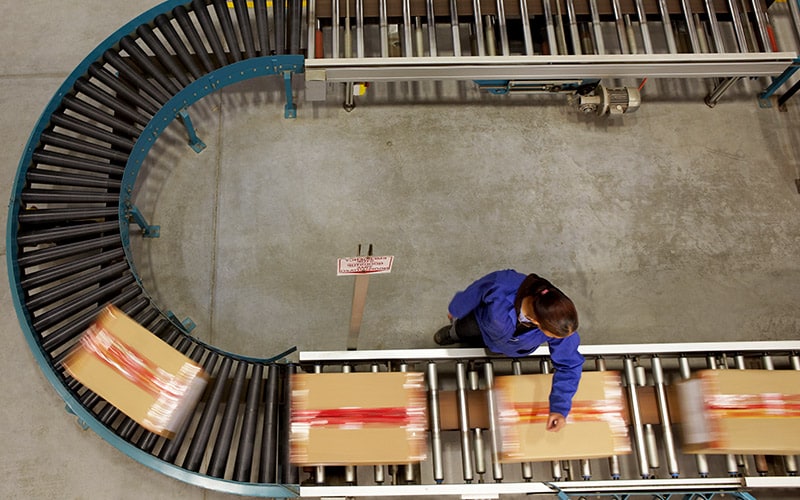Insights
- Semiconductor companies should resolve production yield issues to manage the global chip shortage.
- This requires digital supply chains and operations that comprise interconnected processes and components to automate and optimize tasks while delivering actionable intelligence.
- There are four key trends driving better yield:
- End-to-end digitization of people, processes, and machines for optimized switchovers, dynamic machine allocation, precise demand prediction, and other such outcomes.
- Predictive maintenance through AI/ML-based systems for enhanced uptime and less potential breakdowns.
- Better predictive maintenance through cognitive processing for human-like inference across processes and large-scale automation across design, fabrication, warehousing, logistics, and other operations.
- Immersive digital twins for complete, centralized visibility of supply chain processes and AR-based, information-driven process enhancements.
When global manufacturing stalled amid COVID-19 disruptions, semiconductor companies initially braced for cutbacks. Surprisingly though, the demand for semiconductor chips grew — due to increased requirements for laptops, mobile devices, and gaming consoles that facilitate remote work, education, and entertainment. Since then, semiconductor companies have been struggling to meet the needs of several industries, including automotive, consumer electronics, cryptocurrency mining, and energy.
While the global chip shortage may ease in a few months, increasing production is not the only problem here. The industry also faces serious production yield issues. In-factory operations are tough to change and optimize, given the complexities involved with specialized equipment, clean rooms, and high-precision manufacturing. However, the latest technologies powering end-to-end visibility and automation of the supply chain and other operations can help semiconductor companies improve yield and meet benchmarks.
Production yield is a factor of input quality, process discipline, and analytical capabilities
Yield issues within semiconductor production
Production yield is regarded as the single-most important factor in controlling wafer processing costs.1 It affects output per unit of input resources, waste generation, environmental and financial sustainability, time to market, and costs. Hence, yield improvements can provide significant competitive advantages, which are critical in unpredictable economic environments.
Production yield improvement can provide cost competitiveness through optimum resource utilization along with waste reduction — thus achieving sustainable operations
Despite being one of the frontrunners in production efficiency within the manufacturing sector, chipmakers are struggling with yield issues. Intel had to delay production of its 7nm chips by six months in 2020 because of yield degradation.2 And this year, Samsung lost a deal to manufacture Qualcomm’s Snapdragon 8 chips to Taiwan Semiconductor Manufacturing Company (TSMC) due to yield issues. Reportedly, Samsung’s yield rate on 4nm chips was as low as 35%, versus TSMC’s 70%.3 Notably, TSMC too is facing yield issues (on 3nm chips) that could affect its customers, including Advanced Micro Devices (AMD).4
Yield issues primarily occur due to highly complex semiconductor manufacturing processes. A single wafer, which undergoes hundreds of high-precision processes such as oxidation, coating, lithography, baking, etching, doping, and metal deposition, can take between three and six months to be ready for shipping and has to pass stringent quality tests. Even a speck of dust can defect the product. Moreover, the need to implant more transistors on a given chip year after year requires continuous improvements in design and fabrication capabilities.
Manufacturers need to meet high benchmarks to compete successfully. According to Bloomberg research, manufacturing yield rates below 90% are a cause of concern.5 According to benchmarking authority American Productivity & Quality Center (APQC), the top performers (above 75th percentile) in the broader manufacturing sector maintain a 97% success rate for products that pass all quality specifications the first time around.6 In comparison, bottom performers (below 25th percentile) deliver only an 89% success rate, while the median rate is around 94%. This might appear to be a minor difference, but for large-scale, high-precision manufacturing, it can mark the difference between sustainable business growth and outright bankruptcy.
This difference between leaders and everyone else is a factor of the quality of inputs, timeliness of piecing together every part of the value chain, process discipline, and advanced analytics.7 Semiconductor companies should act fast and embrace the latest technologies to successfully deal with these issues. These technologies include artificial intelligence (AI), machine learning (ML), internet of things (IoT) devices, 5G, spatial computing and design, and immersive devices.
Connected operations, better yield
Data and inference drawn using 3D visualizations and interconnected operations effectively optimize production and the supply chain. It may sound simplistic, but executing it perfectly — or at least better than the competition — requires craftsmanship-like diligence. The design of these digital twins is paramount. It defines how and when every piece comes together. Leading companies are digitizing their operations and supply chains and obtaining crucial data to draw actionable inferences. They are also applying AI-powered automation at scale and deploying virtual reality (VR) and augmented reality (AR) to achieve better yields.
End-to-end digitization for fully optimized operations
A single electronic product can contain thousands of smaller parts and materials that should perfectly synchronize for a defect-free and efficient production process. But any waiting time between the switch from one process to another causes yield loss. An integrated system of connected parts and processes can minimize this timing gap. Therefore, an integrated view into the supply chain is essential for external elements, such as suppliers, warehouses, and logistics, and also for the movement of goods inside the factory.
A completely digitized and connected value chain helps identify and minimize the waiting time between process switchovers
A digitally integrated system provides complete visibility into the position, placement, quality, and quantity of inputs for a manufactured product. The end-to-end digitization of production is made possible by connecting raw materials, machines, and software processing through sensors or IoT devices. The data from each node is collected and processed through a central supply chain management system. Notably, this system can be augmented with AI/ML to learn over time and adapt automatically for maximum efficiency, bringing enhanced agility in the manufacturing process by enabling faster changeovers through single-minute exchange of dies and plug-and-produce capabilities.
Further, an integrated system can notify factory workers about the readiness of a machine to produce a defined product, enabling dynamic machine allocation. It can identify the most optimal option by assessing factors such as which machines are idle, which are nearing completion of the previous batch, and which among those are already equipped with some of the tools and dies required. Moreover, companies can deploy robots for loading and unloading items on machines, which helps reduce overall changeover time.
For example, a leading enterprise networking and security equipment manufacturer invested some $2 million in a digital supply chain solution for end-to-end visibility into its operations. The integration of its supply, demand, and inventory management operations helped optimize order fulfilment and improve productivity. The manufacturer achieved better on-time delivery performance (ship-to-first commit of 96% against a target of 95%) and reduced its lead times for inbound supplies, enhancing customer satisfaction scores.
Integrated IoT-based systems also help create a digital thread throughout operations and supply chains. These systems allow companies to gain complete visibility into the operations of suppliers and contract manufacturers, and to plan production schedules according to shipment times. In warehouses, these systems enable goods to be picked and packed in synchronization with transportation schedules of third-party logistics partners. On top of this integrated data-driven system, AI/ML programs can support dynamic demand predictions based on the economic environment, resource availability, and internal utilization. Collectively, end-to-end digitization builds a data-driven culture for all kinds of decision-making.
Predictive maintenance for increased uptime
Digitizing in-factory supply chains also improves yields through on-time predictive maintenance of machines and components, avoiding potential breakdowns and efficiency losses. Data from each machine and its components can be monitored through an AI/ML-powered system that learns and improves maintenance schedules over time. In addition, these systems can automatically alert required users and suggest actions to keep the system running at maximum efficiency through a centralized dashboard. Manufacturers can use such systems to predict the working life and utilization rate of dies, tools, sensors, and the overall equipment effectiveness based on historical data and industry benchmarks.
Digital twins can help with predictive maintenance by bringing every asset, process, and stakeholder under one roof
Such smart, predictive maintenance systems can be developed and optimized by creating a digital twin of the factory and associated supply chain operations. The digital twin connects all stakeholders and assets in a single system that determines the performance of each asset and process. It harnesses sufficient, quality data from lower-level process automation applications and allows modeling engineers and data scientists to detect patterns and convert them into actionable intelligence. The digital twin also helps prioritize assets based on their criticality to the production process. This holistic approach can help identify the smallest of efficiency gaps, which if plugged effectively, can lead to a significant improvement in production yield.
Cognitive processing for smart automation
Cognitive processing refers to the integration of AI-based systems throughout the manufacturing value chain to assist with complete product life cycle management. It brings human-like inference across large-scale processes, ensuring maximum optimization in operations. Through industrial IoT and advanced analytics applications (including unstructured data), companies can monitor and improve product design, manufacturing, distribution, and even end-user applications.
Such intelligent systems can help solve challenges associated with manufacturing data, maintenance and repair of assets and end products, quality control, resource optimization, and supply chain management. They can identify symptoms of a machine failure and analyze related data to suggest targeted repair options. These capabilities are achieved post end-to-end digitization, when products, pallets, containers, etc., are connected through radio frequency, identification tags, and sensors that operate on a long-range wide area network, Wi-Fi, 4G/5G, or Bluetooth.
Cognitive processing allows for just-in-time and automatic picking of products or raw materials within factory or warehouse operations. It also reduces downtime and improves the first-time fix rate.8 In addition, continuous monitoring of product level data improves quality while reducing warranty costs.
Immersive digital twins for swift, data-driven decision-making
3D visualizations in VR and information overlay onto real-world objects through AR can enhance several manufacturing and supply chain operations, resulting in better efficiency and production yield. These operational tasks include product and process design, data and analytics, quality assurance, diagnostics and maintenance, order picking in warehouses, inventory management, and workforce collaboration. While VR enables companies to create digital twins and manage operations centrally with data dashboards, AR can go much deeper to analyze data and performance metrics for inputs, products, assets, and people.
For example, manufacturers can use AR glasses to display the sequence of operations and guidelines for workers to follow regarding each process involved in fabrication. Manufacturers can also apply automatic identification and data collection techniques to scan items and access critical information overlaid onto real objects. Similarly, in warehouse operations, workers can look at products and retrieve their lot information, dispatch times, suggested treatment (packing/storing), and other information to enhance efficiency.
Human-focused technology for better efficiency
The global manufacturing sector is continuously evolving in this digital era. Organizations need to stay nimble and quickly adapt to market dynamics to compete effectively. Going forward, virtual environments (metaverse, digital twins, etc.) will increasingly drive efficiencies in product designs, production, and supply chains — at scale. And these virtual planning and operating spaces will be powered by the confluence of exponential technologies, including AI, 5G, IoT, 3D design, and immersive AR/VR devices.
To make the most of these technologies and gain a competitive edge, companies need to establish a data- and visualization-driven production process. This process will not only improve the yield, but also drive sustainable growth. Infosys’ Digital Radar 2022 report found that technology adoption with human-centric goals increases technology effectiveness and profit growth. This human agenda focuses on holistic consideration regarding the needs of employees (data and tools to make better-informed decisions), consumers (sustainable products), and shareholders (sustainable profits). The future will belong to those who get this right.
References
- Taking the next leap forward in semiconductor yield improvement, Koen De Backer, RJ Huang, Mantana Lertchaitawee, et al., May 2, 2018, McKinsey.
- Intel CEO Bob Swan has said that the debut of the company’s own 7nm manufacturing process has been delayed by a further 6 months due to yield issues, Peter Clarke, July 27, 2020, eeNews Europe.
- Low yield on Samsung’s 4nm process node prompts Qualcomm to go with TSMC for future chips, Adrian Potoroaca, February 23, 2022, Techspot.
- TSMC 3nm yield problems may impact AMD’s future CPU roadmaps, Nivedita Bangari, February 24, 2022, TechnoSports.
- The chip shortage keeps getting worse. Why can’t we just make more?, Ian King, Adrian Leung, and Demetrios Pogkas, May 6, 2021, Bloomberg.
- How to improve first-pass quality yield in manufacturing, February 2022, APQC.
- How to improve first-pass quality yield in manufacturing, February 2022, APQC.
- What is cognitive manufacturing?, January 16, 2019, Metrology News.





